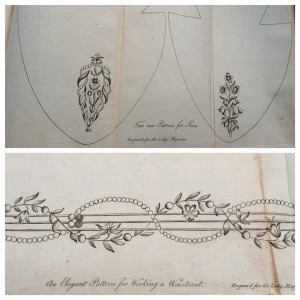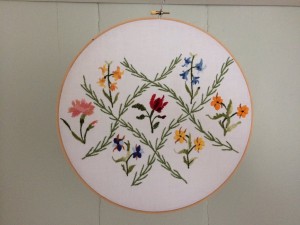The spine – once leather-bound and gilded, now torn for a quarter of its length – has ‘1775’ inked onto it in an old-fashioned hand. Inside the front cover a much more recent pencilled addition reads ‘February onward only. Lacks some of the plates. £5’.
I can’t remember where I bought this sorry-looking copy of the Lady’s Magazine, but I would have grabbed hold of it instantly thanks to the discovery of several folded sheets of embroidery patterns nestling towards the back of the volume, survivors of the binder’s knife. That must be at least 20 years ago: the book has accompanied me through two house-moves and, while not exactly forgotten, has sat largely unnoticed on its shelf ever since. Sheer chance led me to Jennie, to the Lady’s Magazine project, and to the Stitch-Off, and finally (about time too, you may say), those patterns have not only seen the light of day, but are being brought vividly, beautifully back to life by stitchers from all over the world.
Happy though I was to share the patterns, I wasn’t going to be one of those stitchers, I reassured myself. Definitely not. Although I’ve always knitted, sewed and quilted, any embroidery I’ve ever done was in the deep, dark past, forever associated with tray-cloths bearing outlines of crinolined ladies and the transfers on tissue paper that my mother used to buy from the local haberdashery shop (where I later had a Saturday job). But a little voice niggled away at me – what about that muff pattern? Huge (it opens out from the book into a substantial sheet which is still only half-size), complicated-looking and with alarmingly small motifs. But… seductive.
The discovery that I owned not only an embroidery hoop but also embroidery needles and a fairly substantial collection of Anchor threads in a surprisingly large range of colours – yes, I’m a hopeless case who also hoards craft supplies and promptly forgets about them – made me bite the bullet. I would attempt a small section of the muff pattern. It would be an experiment and not intended in any way as a ‘finished’ piece. My abilities were likely – no, certain – to be limited.
In that spirit of nothing ventured, nothing gained, I photocopied a section of pattern and enlarged it slightly. An old, much-washed, cotton pillowcase was cut up to use as the fabric; I rather liked the thriftiness of re-purposing something that had already given good service. Merrily chucking all notions of historical accuracy out of the window, I put the fabric over the pattern against a lampshade, and traced off the designs with a Frixion pen (having first tested that the pen-marks would indeed disappear, as promised, at the first touch of a warm iron). Then the embroidery could begin.
Some weeks and much sotto voce swearing later, I’ve almost finished the ‘experiment’ and am feeling better about it than expected. I’m sure the average 15-year-old reader of my 1775 volume would snigger at my efforts, but I was encouraged by a comment made by another of the contributors to the Stitch-Off, Rachel of www.VirtuoSewAdventures.co.uk.
She astutely pointed out that not every piece of eighteenth-century ‘fancy-work’ would have been perfect. The concept of ‘good enough’ must have applied widely – though I’m sure we’re often misled into thinking otherwise by the gorgeousness of historical dramas on TV, with their improbably exquisite costumes. Surely Jane Austen and her sister Cassandra, or those fashion-mad ladies of Cranford, must have turned a blind eye to the odd botched French knot or wonky bit of stem-stitching? Looking with qualified pride at my own less-than-pristine work, I’m hoping so, anyway.
Author biography
Penny Gore studied Modern History at Liverpool University and spent time working as a cook and in the costume department of Liverpool Museum before joining the staff of what is now the British Library National Sound Archive in London. From there she moved to the equivalent department in the BBC, but soon embarked on a life behind the microphone as a BBC Radio 3 presenter. She is currently a regular presenter of Afternoon on 3 and the BBC Proms. We are very grateful to Penny for so generously making available her patterns for the Stitch Off.
For our report on (and lots of pictures of) the opening of the Stitch Off display and the ‘Emma at 200’ exhibition, please follow this link.
For information about visiting the ‘Emma at 200’ exhibition at Chawton House Library, please follow this link.



